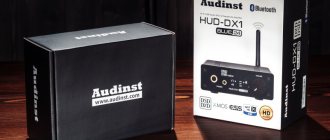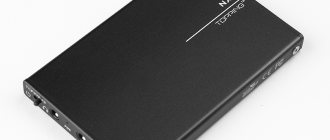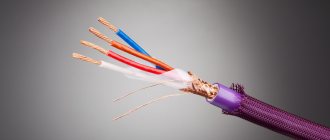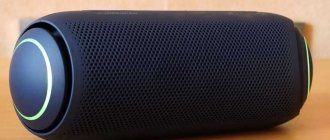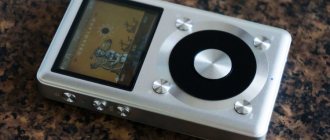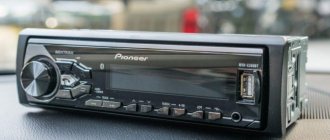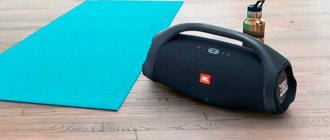What is a DAC?
A DAC is a device that converts information from digital to analog and at the same time improves sound quality (interpretation: digital-to-analog converter).
When using a DAC, the electronic circuit looks like this: audio media > converter > sound. The output supplies current with voltage, which passes through the amplifiers and is supplied to the speaker system. Those. The DAC serves as an “intermediary” between digital and analog standards.
TOP of the best sound amplifiers
DACs are a fast-growing segment of the Hi-End and Hi-Fi markets. And every year the number of models produced only increases.
Burr-Brown:
Multibit:
PCM51, PCM5216-bit predecessors of PCM53, in a ceramic casePCM5316 bit, one of the old but good (1983-86), with parallel inputPCM5416 bit, normal multi-bit (slightly older than PCM56), with parallel inputPCM5516 bit, the same, like PCM54, only in a small SOIC package PCM5616 bit, normal quality multi-bit PCM5818 bit, very good DAC PCM6118 bit, quality like PCM56, but 18 bit PCM6320 bit, one of the Best existing in the world Audio PCM6418 bit, one of the Best, with parallel input PCM65— one of the best, most expensive and rare multi-bits, with parallel input PCM6616 bits, 2 DACs crammed into one case, quality - so-so PCM67 hybrid (multi+single-bit), 2 DACs in one case (stereo)PCM69 hybrid (multi+single-bit ), the same as PCM67PCM170018 bit, 2 DACs in one case (stereo), quality level of PCM61PCM170118 bit, one of the best, heir to PCM58PCM170220 bit technology, slightly lower in quality than PCM63PCM170420 bit, the same as PCM1702, but only capable accept a 24-bit stream (the conversion is still 20-bit)Single bit:
PCM1600 / 1601cheapPCM1607cheapPCM1710regular single-bitPCM1715cheapPCM1716cheap single-bit, accepting 24bit/96kHz.PCM1723cheapPCM1728single-bit, accepting 24bit/96kHz.PCM1732more or less of singlebitPCM1738more or less of one bit, slightly better than PCM1732PCM1792newer single-bit from the 24/192 seriesPCM1794best single-bit among PCM1792-PCM1798 (from the 24/192 series) PCM1796, PCM1798 are the newest single-bits, lower quality than PCM1792Criteria for choosing a DAC for music
Today there are many models of this equipment on the Russian market. Therefore, so that the user does not make a mistake in choosing a DAC, the following parameters must be taken into account before purchasing:
- Entrances. This setting depends on which devices will be used as the audio source. New models are connected to a computer via a USB connector. In addition, optical and coaxial standards are used. Models with wireless technology support are also available on the market.
- Exits. The set of outputs depends on the specific use of the converter. If you purchase it to listen to audio through headphones, you will need a 3.5 mm jack. In other cases, linear and coaxial outputs are needed;
- Sampling and bit depth indicators. These settings affect the audio quality. For the CD format, the bit depth is 16 bits, and for Hi-Res – from 24. And the sampling parameter for CD is 44.1 kHz, for Hi-Res – from 96.
What is HiRes
- Dimensions. This parameter depends on the purpose of the device. Nowadays models with small sizes are relevant. Such converters fit in your pocket and are mainly used with tablets or smartphones.
- Additional functions. Other features worth noting include controlling the device using a remote control and the presence of a headset jack. It is also desirable that the device have analog inputs and the ability to operate the device in preamplifier mode.
- Manufacturer. Many buyers advise purchasing audio DACs from reliable brands. Among the famous manufacturers are the following companies: Cambridge Audio, AudioQuest, Dynavox, etc.
- Price. The price of the device depends not only on the user’s budget, but also on what audio equipment the converter will be used with. For example, it is not recommended to buy an expensive audio DAC if it will work with a weak audio system or with a phone.
How to get the best sound from a CD player, article. Magazine "WHAT HI-FI?"
Save and read later -
Over the past decade, the way we consume music has changed radically. Downloading files and streaming services are widespread today, but with the right approach, the first digital format can bring a lot of joy.
Many of us still have CD players, while others are thinking about purchasing a new model. We'll show you how to get the most out of your new component and music collection. After all, we still buy CDs in bulk ourselves.
Before we get down to business, we would like to remind you that discs require careful handling. Of course, they are not as sensitive to scratches as vinyl, but the best sound can only be obtained from discs with good surface quality. If there are scratches or dirt on the surface of the disc, at best it will sound a little worse, and in the worst case, the sound will “jump” or the player will refuse to play the song altogether. Be careful with the discs and always put them back in the box rather than leaving them lying around the house.
When buying a new turntable, you should choose the best one you can afford. If the information recorded on the disk is not completely retrieved, the lost data cannot be recovered in the subsequent part of the path. Typically, a higher price correlates with higher quality construction and sound.
If you decide to buy a new CD player, consider a model with digital inputs. You can connect other digital sources to them - computers, set-top boxes, DAB radios - and improve their sound quality thanks to the (theoretically) higher-end digital-to-analog converter of the CD player.
This is logical: a specialized audio source is much more often equipped with a good DAC circuit than any of the listed devices.
A CD player needs a reliable base
The first step is to make sure that your new turntable will sit on a secure base so that as little vibration as possible is transferred to it. The most obvious option is an equipment rack. In any case, the platform must be rigid, strictly horizontal and low-resonance.
Vibration does not affect CD players as much as it does vinyl turntables, but footsteps on the floor and even sound from speakers, especially at high volumes, cause the pick-up mechanism to exert more force, which can affect the sound.
The platform must be rigid, strictly horizontal and low-resonance.
If you are not ready to agree with this, conduct an experiment. Place a slightly inflated bicycle tube under the player and listen to see if the sound is different. Do not inflate the bladder all the way; The goal is to make it as soft as possible, but at the same time high enough so that the turntable's feet do not touch the surface of the stand.
It may be difficult to level the CD player horizontally, but the improvements in sound will be worth the effort; and if you don’t notice them, at least have a lot of fun.
It's all about the cables
Almost every CD player comes with a pair of analog cables. Don't consider them as a permanent solution - they are only good for getting started: even a budget player will sound better when connected to high-quality interconnect cables. Don't skimp on spending £30-£50 on a couple.
Most players have analog outputs with simple audio jacks; some boast balanced XLRs - they can provide better sound, although this is not always the case. It all depends on how carefully the balance circuit at the source and amplifier was designed.
Unfortunately, this can only be verified experimentally. In most cases, if we do not consider High-End models, the unbalanced output has higher sound quality, and the balanced output, at most, has higher volume.
Another interesting option that is definitely worth trying is the use of an optical or coaxial digital output: it allows you to connect an external DAC to the player. This method can be useful if your player is working well, but you still want to improve the sound a little more. There are many excellent DAC models on the market; one of the best options is Chord Mojo.
Ease of Management
The most ascetic CD players make do with a minimum of buttons: one for opening and closing the disc tray, two more for starting and stopping playback, and a couple for moving forward and backward through the list of songs. A headphone output with its own volume control is useful for late-night listening.
As a rule, the player comes with a remote control that allows you to control many functions - including those for which there are no buttons on the front panel - as well as pause playback, change songs, etc. If your amplifier is the same brand as your CD player, chances are you can control both components with the same remote control.
Turn off the display
In addition to the number of the song being played, some players display the title and artist name on the display. It may seem strange, but turning off the display will improve the sound quality in most cases, since it itself creates some electrical noise.
Even more surprising may be the effect of disabling the digital outputs.
This feature is available on some models (such as the Award-winning Marantz CD6005) and results in a small but noticeable improvement in clarity and dynamics. Of course, for this to happen, the rest of the system must be fairly transparent. Most CD players sound better with the display off
Filters and upsampling
Much more common is the function of changing the parameters of digital filters. Audiolab uses this approach extensively in its CD players and digital-to-analog converters. Try different options at your own discretion.
The basic set of settings often turns out to be the best according to the results of measurements, but it may well turn out that some other option sounds better. It's worth experimenting with them too.
We don't really like the upsampling feature. If its implementation is not quite perfect, you will get a softer and more elaborate sound, but the attack and enthusiasm of the music will be noticeably weaker.
Selection of system components
Almost any CD player can theoretically work with almost any amplifier. The analog outputs of most turntables produce about 2 volts, plus or minus a few microvolts - this is exactly how much the amplifier's linear input craves. If you're using vintage amps from before the CD era, you may have problems, but a little modification will solve them.
Finally, we cannot help but recall one important rule: the system as a whole does not sound better than its weakest link. If the other components are not very good or do not fit together well, the source update will go almost unnoticed. Happy listening!
Prepared based on materials from the magazine “WHAT HI-FI?”, June 2016
www.whathifi.ru
This article was read 36,484 times
The article is included in the sections:
Useful tips
Panasonic:
AN680616 bit, one of the first from Matsushita, but good in qualityMN355001 bit, cheapMN355111 bit, cheapMN64711 bit, MASH (4 built-in parallel DACs)MN64721 bit, MASH (8 built-in parallel DACs)MN64741 bit, MASH (4 built-in parallel DAC-a)MN647311 bit, MASH -|MN647331 bit, MASH |MN647351 bit, MASH |> are considered the best of the single-bit PanasonicMN64761 bit, MASH | MN64761 - 1 bit, MASH_|MN662711 bit, cheap, all-in-one chipMN6627131 bit, cheap, all-in-one chipYamaha:
YM3015 old, simple YM30 2016 bit, floating point Yamaha YAC5141 bit is considered the best one-bit, newer, average soundSony CDP-337ESD: classic Japanese top manager
This model has already been discussed in detail in the previous material. The device appeared on the market at the very moment when the famous Japanese financial bubble was just beginning to deflate. The Sony CDP-337ESD was an example of what a laser player should be like for a respectable office worker.
Silent mechanics and a string of buttons on a heavy body worked perfectly for the image. And not only. Without any reservations, it is obvious that this is a high-class source, not only in performance, but also in musical resolution.
A comparison of the TDA1541 implementation on the 337ESD with other Philips devices showed that there is a noticeable difference in sound signature between them. What goals did the Dutch and Japanese developers focus on and what is considered success?
In this selection of TDA1541 players, the Sony CDP-337ESD can be awarded as the sharpest and most detailed player. The player was stunning then, and now puts many digital sources to shame. And the CDP-337ESD not only “chats” energetically, but also effectively reveals the contents of the CDs offered to it.
The contrasts in the sound of the symphony are reminiscent of approaching rocks, the synthetic music is drawn like a drawing of an icebreaker. You really believe that this is how it happened. The nature of the Sony CDP-337ESD game is the sound of the 80s, remember the sound of Michael Jackson’s “Bad” album. Now it is clear? It seems that Sony does not leave out a single detail of the phonogram; the sound seems to be filtered through the finest metal sieve and it can no longer be confused with the sound of an analog source, unlike the first Philips. By the way, I like the way “Bad” was recorded. Honestly, I think this is an outstanding piece of recording work. But I wouldn’t want to listen to soundtracks with such intense energy all the time, and the CDP-337ESD is too distracting with its capabilities. But in systems with a soft character, Sony's breath will come in handy and add freshness.
In this example we see that the sound character of the TDA1451 can be adjusted in any direction. Philips used NE5532 operational amplifiers in its players. Sony used the JRC 5532D for the CDP-337ESD. And instead of the SAA7220, the digital filter for the TDA1541 was the Sony CXD1144A, on which the Japanese implemented not 4, but 8-fold oversampling. The result was a car with a completely different style.
It's better to lose 2 bits with a smart person than to find 32 with a fool
In their techno-fetishism, Japanese electronics concerns were often tuned to the maximum numbers of one parameter without taking into account the actual artistic task. This desire later came back to haunt many places.
In the recording industry, this has led to the removal of the “fool proof” that analogue equipment and media necessarily had. On a magnetic master tape, you couldn't endlessly turn up the EQ sliders, otherwise noise would increase in the mix. On a record, you couldn't keep increasing the volume of the mix indefinitely, otherwise you'd lose the stability of the cartridge in the groove. And now everything has become “possible.”
Beauty in other genres has also suffered. Has it ever occurred to you why, even at the level of the family archive, photographs from, for example, 1987/97 evoke more emotions and reflections than from 2007/17? The time intervals are the same, but the difference is like between film and video shooting.
All this time, digital camera manufacturers competed with each other in sterile picture clarity, neglecting photo and film archives, which actually captured the entire history of the 20th century. And even a piece from the 19th century. These people pushed megapixels onto tiny CCD/CMOS matrices instead of studying the quantization of optical-chemical processes in photographic emulsions.
Therefore, even in expensive Pro cameras, the matrix is helpless in the face of overexposure, and the RAW image itself always needs further processing, like makeup on a dead person. Shooting with a digital camera has lost its artistic expression. As a result, we have a bunch of modern films with white skies and billions of dull Instagrams, on which the most ridiculous distortions are superimposed to give a “film look”. But that is another story.
And then, in the early 80s, Philips had to do something to get rid of the stigma of “missing 2 bits”, which continues to this day in the mouth of another fool on the audio forum. First, we managed to beautifully bypass the technical problem in the form of a SAA7030 digital filter with oversampling and a special noise shaper. Thus, the least significant two digits out of 16 were calculated mathematically in the form of three points between the higher order readings. Thanks to this technique and the dynamic current averaging system for resistors (DEM), the resulting monotonicity and other characteristics of the TDA1540 were superior to 16-bit DACs from Sony and Burr-Brown, which stupidly mine the low-order bits “hardwired” with an expected higher error rate.
But few people were interested in these engineering nuances of the TDA1540, both then and now. The most beautiful idea will only bring losses if your rhetoric is not very convincing to the buyer. So Philips groaned a little and began to develop a full 16-bit converter, like everyone else.
The prototype of the TDA1541 chip with gold legs and the name A/N3 (Anton Niko 3) was ready already in 1984. A couple of years later, the TDA1541 supplanted the previous TDA1540 design, not only in its own CD players, but also supplied to other manufacturers, including Sony's partners/competitors. Let's start with it.
